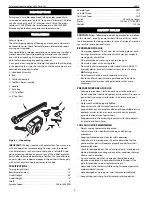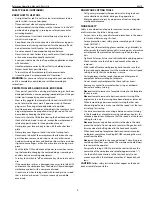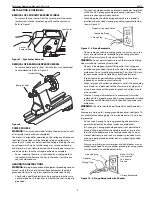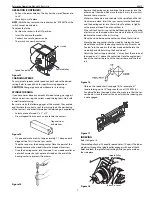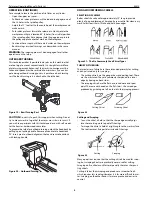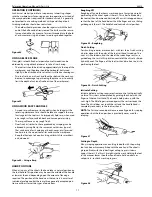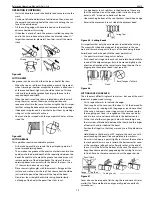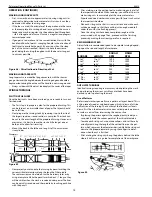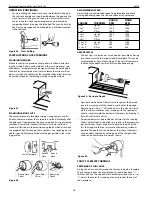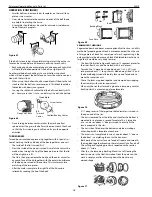
3
SAFETY RULES (CONTINUED)
KNOW HOW TO USE TOOL
•
Use right tool for job. Do not force tool or attachment to do a
job for which it was not designed.
•
Disconnect tool when changing attachments.
•
Avoid accidental start-up. Make sure that the tool is in the “off”
position before plugging in, turning on safety disconnect or
activating breakers.
•
Do not force tool. It will work most efficiently at the rate for
which it was designed.
•
Keep hands away from chuck, centers and other moving parts.
•
Never leave tool running unattended. Turn the power off and
do not leave tool until it comes to a complete stop.
•
Do not overreach. Keep proper footing and balance.
•
Never stand on tool. Serious injury could occur if tool is tipped
or if centers are unintentionally contacted.
•
Know your tool. Learn the tool's operation, application and spe-
cific limitations.
•
Handle workpiece correctly. Mount firmly in holding devices.
Protect hands from possible injury.
•
Turn machine off if workpiece splits or becomes loose.
•
Use cutting tools as recommended in “Operation.”
WARNING:
For your own safety, do not operate your wood lathe
until it is completely assembled and installed according to
instructions.
PROTECTION: EYES, HANDS, FACE, BODY, EARS
•
If any part of your lathe is missing, malfunctioning , or has been
damaged or broken, cease operating immediately until the par-
ticular part is properly repaired or replaced.
•
Wear safety goggles that comply with United States ANSI Z87.1
and a face shield or dust mask if operation is dusty. Wear ear
plugs or muffs during extended periods of operation.
•
Small loose pieces of wood or other objects that contact a spin-
ning workpiece can be propelled at very high speed. This can
be avoided by keeping the lathe clean.
•
Never turn the lathe ON before clearing the bed, head and tail-
stock of all tools, wood scraps, etc., except the workpiece and
related support devices for the operation planned.
•
Never place your face or body in line with the chuck or face-
plate.
•
Never place your fingers or hands in path of cutting tools.
•
Never reach in back of the workpiece with either hand to sup-
port the piece, remove wood scraps, or for any other reason.
Avoid awkward operations and hand positions where a sudden
slip could cause fingers or hand to move into a spinning work-
piece.
•
Shut the lathe OFF and disconnect power source when remov-
ing the faceplate, changing the center, adding or removing an
auxiliary device, or making adjustments.
•
Turn key lock switch to “off” and remove key when tool is not in
use.
•
If the workpiece splits or is damaged in any way, turn lathe OFF
and remove the workpiece from the holders. Discard damaged
workpiece and start with a new piece of wood.
•
Use extra care when turning wood with twisted grain or wood
that is twisted or bowed – it may cut unevenly or wobble
excessively.
KNOW YOUR CUTTING TOOLS
•
Dull, gummy, improperly sharpened or set cutting tools can
cause vibration and chatter during cutting operations.
Minimize potential injury by proper care of tools and regular
machine maintenance.
THINK SAFETY
Safety is a combination of operator common sense and alertness
at all times when the lathe is being used.
•
For your own safety, read all rules and precautions in the opera-
tor's manual before using this tool.
•
For eye protection, wear safety glasses complying with United
States ANSI Z87.1.
•
Do not wear loose clothing, gloves, neckties, rings, bracelets or
other jewelry that could get caught in moving parts of machine
or workpiece. Wear protective hair covering to contain long
hair.
•
Tighten all clamps, fixtures and tailstock before applying power.
Check to make sure that all tools and wrenches have been
removed.
•
With switch off, rotate workpiece by hand to make sure that
there is adequate clearance. Start the machine on lowest speed
setting to verify that the workpiece is secure.
•
For large pieces, create a rough shape on another piece of
equipment before installing on faceplate.
•
Do not mount any workpieces that have splits or knots.
•
Remove any center from spindle when using an outboard
device for auxiliary turning.
•
Never
attempt to remount a faceplate turning to the faceplate
for any reason.
•
Never
attempt to remount a between-centers turning if the
original centers on the turning have been altered or removed.
•
When remounting a between-centers turning that has non-
altered original centers, make sure that the speed is at the low-
est setting for start-up.
•
Use extra caution when mounting a between-centers turning
to the faceplate, or a faceplate turning to between-centers, for
secondary operations. Make sure that the speed is at the lowest
setting for start-up.
•
Never
perform any operation with this lathe where the work-
piece is hand-held. Do not mount a reamer, milling cutter, drill
bit, wire wheel or buffing wheel to the headstock spindle.
•
When hand-sanding faceplate or between-centers mounted
workpieces, complete all sanding BEFORE removing the work-
piece from the lathe.
•
Never
run the spindle in the wrong direction. The cutting tool
could be pulled from your hands. The workpiece should always
turn towards the operator.
•
For spindle turning, ALWAYS position the tool rest above the
centerline of the workpiece and spindle (approximately
1
/
8
″
).
•
Use the drill chuck accessory in the tail stock only. Do not
mount any drill bit that extends more than 6
″
beyond chuck
jaws.
CAUTION:
Follow safety instructions that appear on the head-
stock assembly for your lathe.
Palmgren Operating Manual & Parts List
84315


